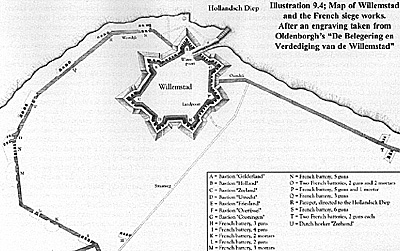Klundert and Willemstad 1793
Dutch During the
Revolutionary Wars Part 9
Siege of Willemstad: March 1 and 2, 1793
by Geert van Uythoven, Netherlands
| |
Friday, 1 MarchNext day [10] the French attacked Willemstad. At seven o’clock in the morning they opened fire on the fortress with a battery consisting of five 18-pdr and 24-pdr guns, which had been captured in Klundert. The battery was raised behind the Drogedijk [11] , southwest of Willemstad. The alarm was given and the garrison took up its designated positions. It appeared that the French took the church as their mark, because it was hit a number of times.
As a result the hospital, which was set up inside the church, had to be moved, and all sick and wounded were transferred to the barracks. The bombardment on the small fortress was intense. For example, the fourth cannonball fired - an 18pdr - hit a house near the harbour, entering the front and leaving through the rear wall, and after this smashing the leg of a grenadier of the Regiment Saxen-Gotha
who stood guard.
At around four o’clock in the afternoon a number of tents were pitched right behind the walls; it was expected that the bombardment would not cease during the night, and that it would be a lot safer for the garrison to sleep in these tents then in their barracks. Furthermore, it would take less time for the soldiers to reach their designated positions. However, while erecting the tents, two men were badly wounded.
At around seven o’clock in the evening the bombardment ceased. Up till now over five hundred projectiles had been thrown into the city, doing considerable damage. The bombardment was resumed around half past eight. This time another battery of four guns, situated behind the Westdijk, added its fire to the bombardment, throwing inside the fortress red-hot ball and howitzer shells. A few hours’ later French
infantry tried to storm the walls at two places; on the western side, near the Westbeer, and on the eastside near the Oostbeer.
The French advance was noticed in time, and when they came near the fortress were showered with musketry and grapeshot, and had to retreat with loss. Now a third French battery armed with three guns, situated at the Straatweg (H), added its fire to the bombardment. This battery shot howitzer shells, ball and grenades. The church was set on fire, but the garrison, aided by some citizens, quickly extinguished it. The bombardment lasted till two o’clock in the night. In the evening the garrison was strengthened by a detachment from Hellevoetsluis, consisting
of a bombardier and twelve gunners. [12]
In the early morning the Governor Van Boetzelaer received message that the powder magazine had been destroyed by the enemy gunfire. He immediately dispatched the Captain of the Engineers Berg to look at the damage. It appeared that only the southern wall had received minor
damage from a cannon ball. However, he advised to empty the powder magazine partially. For that purpose he was allotted four soldiers from each company, which were ordered to dig holes in the courtines [13] , to be filled with the powder. During the morning, twelve of these small magazines were made, filled with about 10,000 pounds of powder.
Between seven and eight o’clock in the morning the French resumed their bombardment. The bombardment lasted till noon, only to be resumed an hour later. The bombardment lasted until half past five, and was again resumed at seven o’clock, lasting till nine. The damage done to the houses inside the fortress, especially to the roofs, was enormous. The garrison, constantly on duty, suffered severely. A very strong
northeastern wind was blowing, and it was so cold that the soldiers at the batteries had blankets wrapped round them to prevent themselves from freezing.
[1] 1 Pieter Christiaan Colthof was born on 21 October 1766, son of Johannes Leonardus Colthof and Sara Elizabeth Honkoop. During 1787, the Prussian invasion of Holland, as a lieutenant he commanded the artillery in Klundert,
siding with the Orangist party. A few days before the French march into the Dutch Republic he was promoted to 1st Lieutenant. Being made prisoner while nailing the guns as described. After his release as prisoner of war promoted to captain on 10 October 1793. When the Dutch
Republic had ceased to exist he resigned in April 1795. In 1799, after the ill-fated invasion of Holland by the British and Russian armies, he signed up in British service, receiving the rank of major. He served in the British army until 1802. When his fatherland became independent again
he entered Netherlands service, on 24 February 1814 as a major in the 13th Militia Battalion, On 24 April 1815 he became lieutenant colonel in the 15th Militia Battalion. He died on 5 April 1831. In 1793 his two brothers were also serving in the army of the Dutch Republic: Simon Jacobus Colthof as a lieutenant, commanding the artillery in Willemstad and, Frederik Pieter Colthof as an ensign in the Regiment No. 8 Bosc de la Calmette, also in garrison in Willemstad. See the second part of this article and the next article for more details about the siege of Willemstad
(source: “Beleg en verdediging van Willemstad in 1793” by Van Nispen).
Klundert and Willemstad 1793 Dutch in Revolutionary Wars Part 9
The Dutch During the Revolutionary Wars
|

 Illustration 9.4; Map of Willemstad and the French siege works. After an engraving taken from Oldenborgh’s “De Belegering en Verdediging van de Willemstad.”
Illustration 9.4; Map of Willemstad and the French siege works. After an engraving taken from Oldenborgh’s “De Belegering en Verdediging van de Willemstad.”